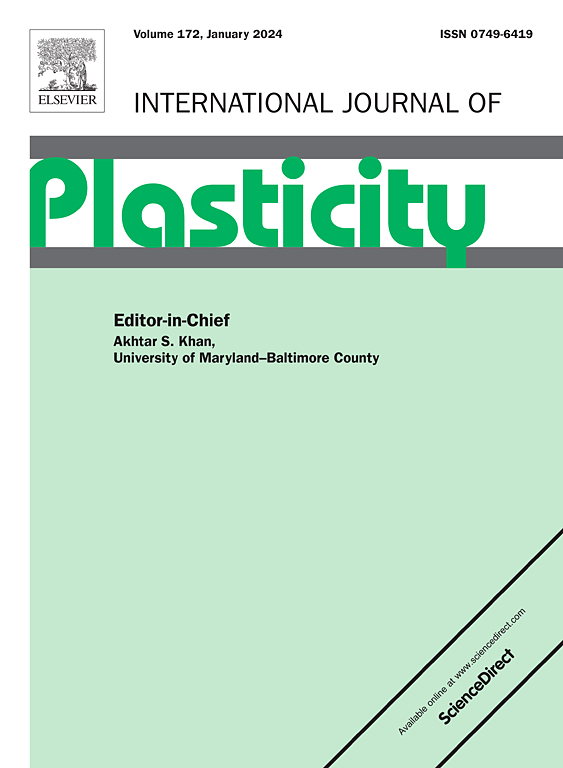A texture-dependent yield criterion based on Support Vector Classification
IF 9.4
1区 材料科学
Q1 ENGINEERING, MECHANICAL
引用次数: 0
Abstract
Conventional yield criteria for anisotropic plasticity rely on linear transformations of the stress tensor to map the directional dependence of critical stress tensors at yield onset onto a unit sphere in stress space. These linear transformations are made material specific by a number of anisotropic parameters, which need to be determined by experimental procedures for each material. One drawback of this approach is that these anisotropic parameters cannot be explicitly expressed as functions of the crystallographic texture. Hence, any change in the texture of a material, as it occurs during cold deformation, requires a complete re-parametrization of the yield function. In this work, we present a data-oriented yield criterion based on Support Vector Classification (SVC) that is an explicit function of the crystallographic texture. This texture-dependency is achieved by including the coefficients of the general spherical harmonics (GSH) series expansion of the orientation distribution function (ODF) to the feature space of the machine learning model. The capabilities of the proposed yield criterion are demonstrated by training the model on a dataset containing micromechanical data from over 8000 distinct cubic-orthorhombic textures. The trained SVC combines the efficiency of classical phenomenological models with the flexibility of elaborate CP models. It provides a path to efficient hierarchical materials modeling as the anisotropy of the macroscopic yield onset is explicitly linked to the crystallographic texture.


基于支持向量分类的纹理相关屈服准则
各向异性塑性的传统屈服标准依赖于应力张量的线性变换,将屈服开始时临界应力张量的方向依赖性映射到应力空间的单位球体上。这些线性变换是通过一些各向异性参数使材料特定的,这些参数需要通过实验程序为每种材料确定。这种方法的一个缺点是,这些各向异性参数无法明确表示为晶体纹理的函数。因此,材料质地的任何变化,如在冷变形过程中发生的变化,都需要对屈服函数进行全面的重新参数化。在这项工作中,我们基于支持向量分类(SVC)提出了一种以数据为导向的屈服标准,它是晶体学纹理的明确函数。这种纹理依赖性是通过将取向分布函数(ODF)的一般球面谐波(GSH)序列展开系数纳入机器学习模型的特征空间来实现的。通过在包含来自 8000 多个不同立方正方体纹理的微观机械数据的数据集上训练模型,证明了所提出的屈服标准的能力。训练后的 SVC 将经典现象学模型的高效性与复杂 CP 模型的灵活性相结合。由于宏观屈服起始的各向异性与晶体学质地明确相关,因此它为高效的分层材料建模提供了一条途径。
本文章由计算机程序翻译,如有差异,请以英文原文为准。
求助全文
约1分钟内获得全文
求助全文
来源期刊

International Journal of Plasticity
工程技术-材料科学:综合
CiteScore
15.30
自引率
26.50%
发文量
256
审稿时长
46 days
期刊介绍:
International Journal of Plasticity aims to present original research encompassing all facets of plastic deformation, damage, and fracture behavior in both isotropic and anisotropic solids. This includes exploring the thermodynamics of plasticity and fracture, continuum theory, and macroscopic as well as microscopic phenomena.
Topics of interest span the plastic behavior of single crystals and polycrystalline metals, ceramics, rocks, soils, composites, nanocrystalline and microelectronics materials, shape memory alloys, ferroelectric ceramics, thin films, and polymers. Additionally, the journal covers plasticity aspects of failure and fracture mechanics. Contributions involving significant experimental, numerical, or theoretical advancements that enhance the understanding of the plastic behavior of solids are particularly valued. Papers addressing the modeling of finite nonlinear elastic deformation, bearing similarities to the modeling of plastic deformation, are also welcomed.
 求助内容:
求助内容: 应助结果提醒方式:
应助结果提醒方式:


